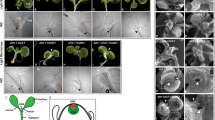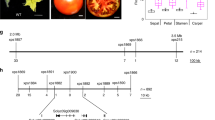Abstract
Unlike monopodial plants, in which flowering terminates growth of a shoot, plants exhibiting sympodial shoot architecture maintain the potential for indeterminate growth even after converting to floral development. This vegetative indeterminacy is conferred by a special type of axillary meristem, the sympodial meristem, which exhibits precocious but determinate growth. The reiterative formation of sympodial meristems as the plant grows results in a shoot composed of a series of modules, each consisting of a limited number of vegetative nodes and terminated by a flower or inflorescence. To determine how sympodial meristems differ from other shoot meristems, we examined interactions between mutations that affect various shoot meristem types in tomato (Lycopersicon esculentum Mill.). Analysis of double mutant combinations of jointless, lateral suppressor, self-pruning, blind, and anantha showed that sympodial meristems share regulatory features with inflorescence meristems. Genetic studies on the jointless mutation implicated this gene in suppressing sympodial meristem fate in the inflorescence. As this mutation has a second phenotype, the elimination of the pedicel abscission zone, we examined the expression pattern of JOINTLESS to test whether pedicel development is involved in directing shoot architecture. We found that this MADS box gene is expressed in a variety of shoot meristems, including inflorescence, floral, sympodial, and axillary meristems, as well as in early staged floral organs, in sporogenous tissues of anthers, and in ovules. Lack of expression in developing pedicels indicates abscission zone development does not rely on JOINTLESS transcription in the differentiating cells. We conclude that the primary role of JOINTLESS is to suppress sympodial meristem identity in inflorescence meristems.








Similar content being viewed by others
References
Allen KD, Sussex IM (1996) Falsiflora and anantha control early stages of floral meristem development in tomato (Lycopersicon esculentum Mill). Planta 200:254–264
Ampomah-Dwamena C, Morris B, Sutherland P, Veit B, Yao J-L (2002) Down-regulation of TM29, a tomato SEPALLATA homolog, causes parthenocarpic fruit development and floral reversion. Plant Physiol 130: 605–617
Butler L (1936) Inherited characters in the tomato. II. Jointless pedicel. J Hered 37:25–26
Greb T, Clarenz O, Schafer E, Muller D, Herrero R, Schmitz G, Theres K (2003) Molecular analysis of the LATERAL SUPPRESSOR gene in Arabidopsis reveals a conserved control mechanism for axillary meristem formation. Genes Dev 17:1175–1187
Ishida BK, Jenkins SM, Say B (1998) Induction of AGAMOUS gene expression plays a key role in ripening of tomato sepals in vitro. Plant Mol Biol 36:733–739
Leyser O (2003) Regulation of shoot branching by auxin. Trends Plant Sci 8:541–545
Malayer JC, Guard AT (1964) A comparative developmental study of the mutant side-shootless and normal tomato plants. Am J Bot 51: 140–143
Mao L, Begum D, Chuang HW, Budiman MA, Szymkowiak EJ, Irish EE, Wing RA (2000) JOINTLESS is a MADS-box gene in tomato controlling flower abscission zone development. Nature 406:910–913
Martienssen R, Irish V (1999) Copying out our ABC’s: the role of gene redundancy in interpreting genetic hierarchies. Trends Genet 15: 435–437
Molinero-Rosales N, Jamilena M, Zurita S, Gomez P, Capel J, Lozano R (1999) FALSIFLORA, the tomato homologue of FLORICAULA and LEAFY, controls flowering time and floral meristem identity. Plant J 20:685–693
Molinero-Rosales N, Latorre A, Jamilena M, Lozano R (2004) single flower truss regulates the transition and maintenance of flowering in tomato. Planta 218:427–434
Napoli CA, Ruehle J (1996) New mutations affecting meristem growth and potential in Petunia hybrida Vilm. J Hered 87:371–377
Paddock EF, Alexander LJ (1952) Cauliflower, a new recessive mutation in tomato. Ohio J Sci 52:327–334
Pnueli L, Carmen-Goren L, Hareven D, Gutfinger T, Alvarez J, Ganai M, Zamir D, Lifschitz E (1998) The SELF-PRUNING gene of tomato regulates vegetative to sympodial switching of sympodal meristems and is the ortholog of CEN and TFL1. Devel 125:1979–1989
Rick C, Butler L (1956) Cytogenetics of tomato. Adv Genet 8:267–382
Sawhney VK, Greyson RI (1972) On the initiation of the inflorescence and floral organs in tomato (Lycopersicon esculentum). Can J Bot 50:1493–1495
Schmitz G, Theres K (1999) Genetic control of branching in Arabidopsis and tomato. Curr Opin Plant Biol 2:51–55
Schmitz G, Tillmann E, Carriero F, Fiore C, Cellini F, Theres K (2002) The tomato Blind gene encodes a MYB transcription factor that controls the formation of lateral meristems. Proc Natl Acad Sci USA 99: 1064–1069
Schumacher K, Schmitt T, Rossberg M, Schmitz G, Theres K (1999) The Lateral suppressor (Ls) gene of tomato encodes a new member of the VHIID protein family. Proc Natl Acad Sci USA 96:290–295
Stubbe H (1964) Mutanten der Kulturtomate Lycopersicon esculentum Miller V. Kutlurpflantze 12:121–152
Szymkowiak EJ, Irish EE (1999) Interactions between jointless and wild-type tissues during development of the pedicel abscission zone and the inflorescence meristem in tomato graft chimeras. Plant Cell 11: 159–174
Vrebalov J, Ruesinsky D, Padmanabhan V, White R, Medarano D, Drake R, Schuch W, Giovannoni (2002) A MADS-box gene necessary for fruit ripening at the tomato Ripening-Inhibitor (Rin) locus. Science 296: 343–346
Williams W (1960) The effect of selection on the manifold expression of the “suppressed lateral” gene in the tomato. J Hered 14:285–296
Yeager AF (1927) Determinate growth in the tomato.J Hered 18:263–265
Acknowledgments
This research was supported by NSF grant IBN 00-90417. We thank Chi-Lien Cheng and Karim Gasimov for their helpful suggestions on the manuscript.
Author information
Authors and Affiliations
Corresponding author
Rights and permissions
About this article
Cite this article
Szymkowiak, E.J., Irish, E.E. JOINTLESS suppresses sympodial identity in inflorescence meristems of tomato. Planta 223, 646–658 (2006). https://doi.org/10.1007/s00425-005-0115-x
Received:
Accepted:
Published:
Issue Date:
DOI: https://doi.org/10.1007/s00425-005-0115-x




